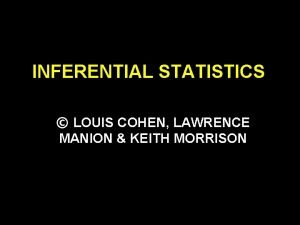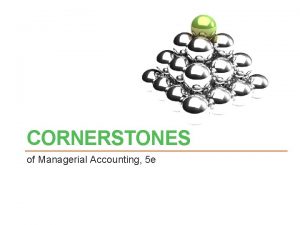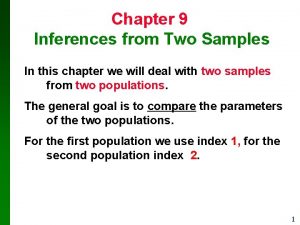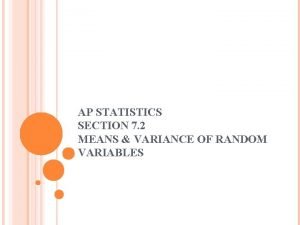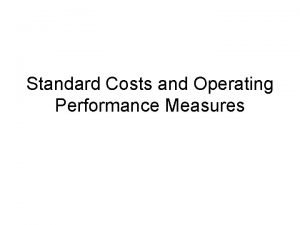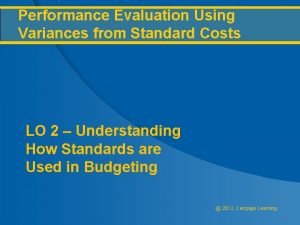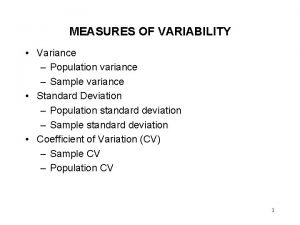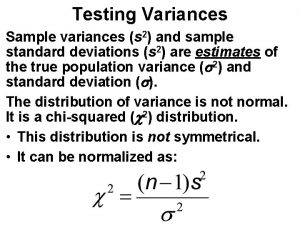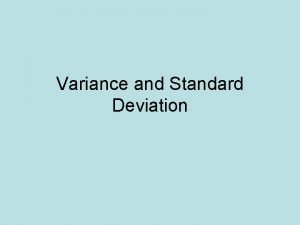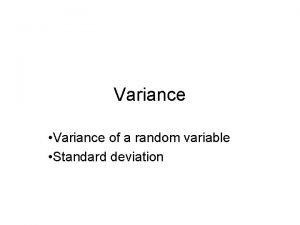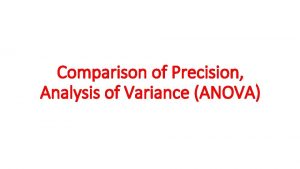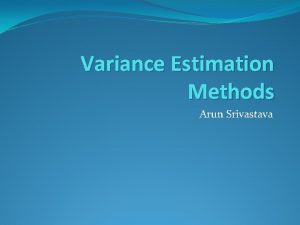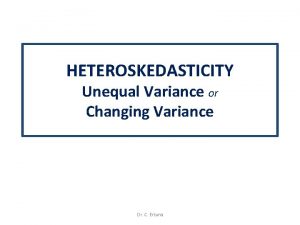Introduction to Variances Variances A variance is the
























- Slides: 24

Introduction to Variances

Variances • A variance is the difference – between actual costs and standard costs – or between actual costs/revenue and budget costs/revenue – what actually occurred and what was expected to occur • By analysing the variance, mangers seek to • identify problems which need further investigation with a view to implementing remedial action This is known as variance analysis and its value lies in managers being able to isolate where increased costs are actually occurring and to take remedial action in that specific area

Budgets and standards • Variances can be calculated on standard cost • • figures or on budgets Standard costs and budgets have one feature in common - they are both pre-determined figures relating to what is expected in the future But there is an important distinction between standard costs and budget figures Standard costs refer to the expected cost per unit Budget figures can refer to cost and/or revenue and concern aggregates - the total output of a one product, the total costs of one department

Variance • The difference between the budgeted or forecast • level of costs and revenue and the actual levels Positive/favourable variance – – – a better than expected result costs lower or revenue higher than expected should led to higher than expected profits – – – a worse than expected result costs higher or revenue lower than expected should led to lower than expected profits • Negative/adverse/unfavourable variance

Management by exception • This is defined as the practice of focussing on activities requiring attention and ignoring those that appear to be running smoothly • It is the process of collecting and acting upon exceptional variances • Variance analysis facilitates management by exception by highlighting areas of the business which deviate from

Steps to be taken • Identify the variance • Calculate the variance • Analyse and explain the variance • Attribute responsibility for the variance • Take action to correct the problem

Types of variance • Sales variance - sales revenue different from expected • Materials variance - cost of direct materials different from expected • Labour variance - cost of direct labour different from expected • Overhead variance - overhead costs different from expected

Quantity or price? • In all cases the variance is caused by either: – a price which is different from that planned – volume which is different from that planned • It is possible that a variance might be caused by a combination of the two • The purpose of variance analysis is to separate out the two elements

Sales revenue variance • This relates to sales revenue being different from expected • It is the result of either: • Sales volume variance - caused by the actual quantity sold being different from the planned volume • Sales price variance - caused by a difference in the price actually paid compared to that in the budget

Sales variance Favourable • Sold more because of Unfavourable • Sold less because of • Sold at a higher price • Sold at a lower than – good marketing conditions – successful marketing because of – unexpected market demand – growth in the economy. – unfavourable market conditions – ineffective marketing expected price because of – tough competition – recession in the economy

Sales volume variance Explanation for adverse variance: • Increased competition • Decline in the life cycle • Problems with the marketing mix • Variations in marketing effectiveness • Unusually adverse economic conditions • Activities of competitors • Changing fashions or consumer tastes • Raised selling prices Explanations for favourable variance • Reduced competition • Unexpectedly successful marketing • Unusually good market conditions • Favourable movement in fashions • Lower selling price

Sales price variance Explanations for adverse variance • Reduced selling price for large quantities • Special prices for special customers • Promotional offers • Special out of season sales • Price reductions to reduce stocks and/or improve cash flow Explanations for favourable variance • Increase selling price for small quantities • Price rises to take advantage of high level of demand • Price rises following rise in costs

Material variances • Variance on the cost of materials used as inputs can be attributed to: • Materials price variance – difference between planned cost and the actual cost per unit of materials used • and/or • Materials usage variance – the difference between the planned quantity of materials used and the actual quantity used

Direct materials variance Favourable • Used less material than expected because of – high quality material – efficient production • Material costs less than expected because of – purchase of cheaper alternative supplies Unfavourable • Used more material than expected because of – poor quality material – inefficient production • Material costs are higher than expected because of – increased competition for inputs leading to a rise in price

Materials price variance Possible explanations for adverse variance • Different supplier from usual • Unexpected general price rise • Substitution of different grade of material • Careless purchasing • Change in purchase price • Errors in pricing • Depreciation in the exchange rate (for imported inputs) Possible explanations for favourable variance • Different supplier from usual • Benefited from unforeseen discounts • Substitution of a different grade of material • Rise in the exchange rate (for imported materials)

Material usage variance Possible explanations for adverse variance: • Higher incidence of scrap or theft • Poor quality of materials • Alteration in product design • Substitution of a different grade of material • Less efficient use of materials • Errors in allocating materials to jobs • Stricter quality control • Defective materials • Reworking of defective production • Inefficient workers • Poor machinery. Possible explanations for favourable variance • Used less material because of low demand • Alteration in product design • Substitution of a different grade of material • Less waste • Improved efficiency • Quality control less stringent

Labour variance • This type of variance is related to the cost of • • • labour employed. It is linked to the price of labour and/or its efficiency. Labour rate (price) variance - labour available at a price different from expected. The variance is the difference between the wage rate that was expected to be paid and the wage rate actually paid. Labour efficiency variance - production required more (or less) labour than expected or planned. It is caused by labour being more (or less) efficient than was expected.

Labour rate variance • Differences in labour costs caused by variations in the rate of paq Possible causes: • Unexpected national pay rise • Bonus different from the plan • Substitution of a different grade of labour • Labour paid at overtime or premium rate

Labour efficiency variance Possible explanations for adverse variance: • Rise in unavoidable idle time • Change in the motivation of the workforce • Substitution of a different grade of labour • Errors in allocating time to jobs • Worker inefficiency • Poor planning • Materials shortage • Use of non-standard or defective materials • Machine breakdown • Use of inadequately trained labour Possible explanations for favourable variance • Improvement in working methods • Increase efficiency • Increase in motivation • Use of a different grade of labour • Lower than expected idle or downtime

Overhead variances • Variable overhead variances – changes in variable overheads e. g. water, gas, electricity • Variable overhead efficiency variance – changes in activity levels linked to labour or machine hours worked • Fixed overhead expenditure variance – change in price of fixed overheads - rent, standing charges • Fixed overhead volume variance – • Change in activity levels linked with labour efficiency of machinery

The interdependence of variances • The cause of a particular variance may affect another variance in a corresponding or in opposite way • Workers trying to improve productivity (favourable labour efficiency variance) might become careless and waste more material (adverse material usage variance) • The use of a lower grade of labour might produce a favourable labour rate variance but an adverse variance on materials

The interdependence of variances • A new improved machine becomes available which causes – an adverse fixed overhead expenditure variance (because this machine is more expensive and depreciation is higher) – favourable wage efficiency and fixed overhead volume variances (higher productivity)

The interdependence of variances • If supplies of a specified material are not available, this may lead to – a favourable price variance (cheaper material used) – an adverse usage variance (cheaper material caused more wastage) – an adverse fixed overhead volume variance (production delayed while material was unavailable) – an adverse sales volume variance (unable to meet demand due to production difficulties)

Responding to adverse variance Sales variances • Seek new markets • Update/extend product range • Increase promotion • Change distribution strategy • Improve company image • Improve product quality • Cut prices Cost variances • Cut wages • Increase labour productivity • Seek cheaper inputs • Reduce waste • Improve quality to reduce defective goods • Training • More efficient HRM • Seek new cheaper suppliers • Negotiate long term contracts
 Standard costing and variance analysis formulas
Standard costing and variance analysis formulas Eta squared statistics
Eta squared statistics Direct labor variances categories
Direct labor variances categories Comparing two population variances
Comparing two population variances An income statement reporting variances from standard costs
An income statement reporting variances from standard costs Variance analysis
Variance analysis Ap statistics rules for means and variances
Ap statistics rules for means and variances Rules for means and variances
Rules for means and variances Ultra shine company manufactures a cleaning solvent
Ultra shine company manufactures a cleaning solvent Performance evaluation using variances from standard costs
Performance evaluation using variances from standard costs Mike mozer
Mike mozer Introduction to analysis of variance
Introduction to analysis of variance Hát kết hợp bộ gõ cơ thể
Hát kết hợp bộ gõ cơ thể Bổ thể
Bổ thể Tỉ lệ cơ thể trẻ em
Tỉ lệ cơ thể trẻ em Voi kéo gỗ như thế nào
Voi kéo gỗ như thế nào Chụp phim tư thế worms-breton
Chụp phim tư thế worms-breton Hát lên người ơi
Hát lên người ơi Các môn thể thao bắt đầu bằng tiếng nhảy
Các môn thể thao bắt đầu bằng tiếng nhảy Thế nào là hệ số cao nhất
Thế nào là hệ số cao nhất Các châu lục và đại dương trên thế giới
Các châu lục và đại dương trên thế giới Công của trọng lực
Công của trọng lực Trời xanh đây là của chúng ta thể thơ
Trời xanh đây là của chúng ta thể thơ Mật thư tọa độ 5x5
Mật thư tọa độ 5x5

